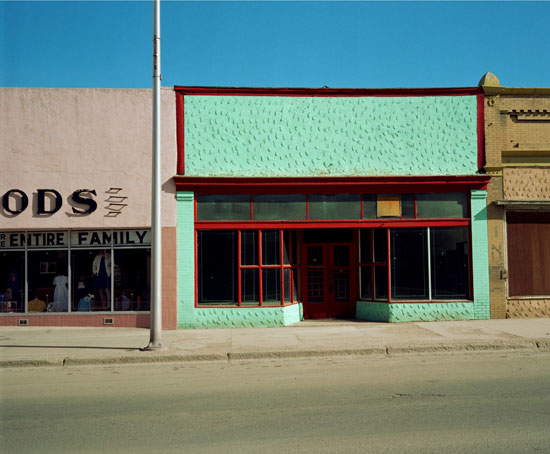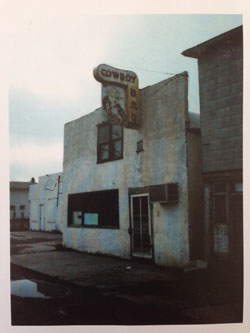In one of the most important scenes in Wim Wenders’ fim Paris, Texas (1984), the protagonist Travis hands his brother a wasted photograph depicting the Texas desert in the middle of which a wooden sign stands out with an inscription, for sale. It is the piece of land he had purchased a few years earlier: it is located in the town of Paris, Texas (hence the title of the film), where Travis had been conceived, and to better find his origins he had decided to physically take possession of it. One of the salient features of American culture, according to Wim Wenders, is the need to build, and building can start even simply from a sign, a signpost: this is the idea behind the photograph Western World Development, which is quite similar to what we see in Paris, Texas. Except that the desert is California ’s and the almost faded lettering on the sign reads “Western World Development. Tract 8271.” It is as if there, amidst the rocks, sand, and shrubs, someone wanted to lay the groundwork for something grandiose, which was then unrealized. Theimage then becomes, as in Paris, Texas, the means both to show a place or situation and to tell a story.
 |
| Wim Wenders, Western World Development, Near four corners, 1986 |
Wim Wenders’America is one that goes beyond clichés. His photography is warm, often shining with a dazzling light like that of the Texas desert, offering flashes of bright blue sky. But (and this will be well understood by those who, again, have seen Paris, Texas) the sense we get from it is not one of cheerfulness, happiness. There is always a restless soul that accompanies Wim Wenders’ photographs: somewhat like what happens in Edward Hopper’s painting, where the images convey a strong sense of melancholy. Wim Wenders’ Las Vegas, for example, is not Nevada ’s with its casinos, its colorful neon signs, its teeming nightlife, its vocation for vice and debauchery. The Las Vegas of Wim Wenders is a small town in New Mexico, where on the dusty streets there are stores, yes brightly colored with bright hues, but empty: there is no one in the street. It is a bleak journey whose soundtrack is not the cheerful country songs of the stereotypical American desert, but rather the dejected steel guitars of Ry Cooder, who not coincidentally signed the soundtracks to Paris, Texas.
 |
| Wim Wenders, Entire family, Las Vegas, New Mexico, 1983 |
 |
| Wim Wenders, Cowboy bar |
However, although streets are empty and people are hardly depicted in Wim Wenders’ photographic work, there are very few photographs in which human presence is not perceived. Every photograph by Wim Wenders always depicts an object, a construction, a building made by the human hand. This presence somehow harkens back to a concept that has always permeated art history, namely the transience of existence, which in Wim Wenders’ photographs also involves man-made objects. In the American desert, gas pumps, gas stations, and bars along highways are typical elements of the landscape, mostly dating back to a time when air travel either did not yet exist or could not be the preserve of all social classes, and the only way to get from one part of the country to another economically was by car. Add to this the fact that many mining operations went out of business, thus resulting in the depopulation of villages and towns. And also, the ease of air travel led Americans to move more and more to the coasts. Here, then, is where a picture like Cowboy bar conveys to us this sense of a civilization that “arrives, lingers a little, and then disappears,” in the words of Wim Wenders that we find in an interview published in the 1987 volume Written in the West, which documented, with photographs, the scouting of the settings of Paris, Texas. A civilization that will probably not return: it is an America that has now faded away, it is the memory of a specific period in history.
And this fading also goes along with what Wenders thinks about photography. It is a deep reflection: our desire to take a photograph is felt only when we see a landscape or a building for the first time. When we return to the same place or in front of the same building, we are unlikely to feel like taking a photograph again: it is a feeling we will have experienced almost all of them. The story of that object we photograph ends, for photography, the moment the object is transformed into an image. And that is why photography becomes a method of exploration and discovery. And this exploration can be conducted in the ways and on the subjects that each photographer sees fit: Wim Wenders decided to conduct his exploration on this kind of inner, restless America. Even where we come across what is perhaps the highest symbol of progress made in the USA, skyscrapers, Wim Wenders’ attention lingers on a woman sitting on a window sill: we barely notice her, when set against the grandeur of the buildings and skyscrapers. But she becomes the focal point of the photograph: and so, rather than admiring the grandeur of the architecture, we are led to wonder what that woman must be thinking about, and why her gaze seems fixed in the void.
 |
| Wim Wenders, Woman in the window, 1999 |
All the photographs we have seen so far are on display, until March 29, at the Villa Panza in Varese, in an exhibition entitled Wim Wenders. America that displays thirty-four photographs made by the German director. The exhibition, curated by Anna Bernardini, director of Villa Panza, has been organized in collaboration with FAI (Fondo Ambiente Italiano) and is accompanied by a series of meetings, lectures and film screenings-a not-to-be-missed opportunity for anyone interested in learning more about the links between Wim Wenders and America. As well as to discover the photographs of a great filmmaker.
Warning: the translation into English of the original Italian article was created using automatic tools. We undertake to review all articles, but we do not guarantee the total absence of inaccuracies in the translation due to the program. You can find the original by clicking on the ITA button. If you find any mistake,please contact us.